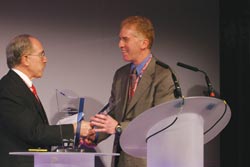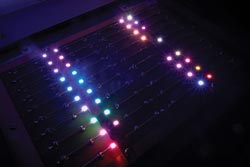COVENTRY, UK – Increased power, long lifetimes and high lumen efficiency make LED sources attractive for domestic lighting. By combining LEDs of different colours, or applying phosphor coatings, manufacturers produce the necessary white-light mix. For example, they may coat a blue indium-gallium-nitride LED with red and green phosphors. Philips Lumileds Lighting Co. of San Jose, Calif., USA, has patented a conformal phosphor coating process to ensure consistency of colour and intensity over time, recognizing the importance of phosphor developments in meeting the growing demand for solid-state illumination-grade LED sources.

Dr. Sergio Kapusta of Shell Global Solutions International presents the UKTI Business Innovation Award for Clean Technologies to Dr. Michael Edelman of Nanoco. Image © Nanoco Technologies.
At EuroLED 2008, Prof. Jack Silver of Brunel University, Uxbridge, UK, discussed the use of cerium- and europium-doped lattices for LED phosphors and the merits of making white light from blue LEDs compared with making it from ultraviolet LEDs. He is also working with semiconducting nanophosphors with rare-earth activators and new-material phosphors based on metal nitrides. The Centre for Phosphors and Display Materials, formed 38 years ago, has long experience with luminescent materials and has developed anti-Stokes phosphors that absorb two or more low-energy photons and emit light of a shorter wavelength; for example, converting infrared light to green. Its interest is in producing new electroluminescent phosphors with improved lifetime and colour gamut.

This picture of Nanoco’s range of coloured cadmium-free quantum dot LEDs under test shows that varying the physical dimensions of quantum dots produces a rainbow of colours, each with a sharp emission spectrum and high quantum efficiency. Image © Nanoco Technologies Ltd.
Another approach is quantum dots. Nanoparticles of semiconductor material have interesting chemical, electronic and optical properties by virtue of their tiny size. Light stimulation makes them emit bright monochromatic light, enabling conversion from one wavelength to another. Dr. James Harris of Nanoco Technologies Ltd. in Manchester, UK, explained that quantum dots are colour-tunable. Varying their size in the range from 2 to 20 nm changes the emitted light from blue through to red. This controls the light mixture, promising high-quality white LEDs. Nanoco produces quantum dots in production quantities, kilograms at a time. Its CFQD (cadmium-free quantum dot) materials are RoHS-compliant and tunable through the UV-VIS-NIR range.
A novel method
Nanoco has developed a novel method of growing nanoparticles around a molecular cluster template. The cluster compound provides nucleation points to seed the crystallization of nanoparticles from chemical precursor liquid. This avoids the harsh conditions and hazardous chemicals of the conventional high-temperature dual-injection technique and provides a scalable process producing quantum dots of consistent quality. In October 2008, the company won the UKTI Business Innovation Award for Clean Technologies for its commercialization of quantum dots in solid-state lighting and printable solar cells.
Incandescent lightbulbs have traditionally been the most popular domestic light source. They emit up to 18 lm/W, dissipating a large proportion of their power as heat, and they last only about 500 hours. European legislation will soon phase these out in favour of energy-saving compact fluorescent lamps (CFLs) to reduce carbon dioxide emissions and energy bills. CFLs have a lifetime of about 3000 hours and output up to 60 lm/W. In contrast, solid-state quantum dot lights have a lifespan up to 50,000 hours, or 20 years of typical domestic usage, and 30- to 70-lm/W efficiency. Unlike the CFL, they turn on instantly.